Camera comparison: Sony Xperia Z2 vs Samsung Galaxy S5, LG G2, HTC One (M8), iPhone 5s
You can now read:
- iPhone 6 vs iPhone 6 Plus vs iPhone 5s vs Galaxy S5 vs LG G3 vs Lumia 1520 vs Xperia Z2 vs HTC One (M8) Camera comparison
- Samsung Galaxy Note 4 vs iPhone 6 vs iPhone 6 Plus vs Sony Xperia Z3 vs LG G3 vs Galaxy S5 vs Galaxy Note 3 Camera comparison
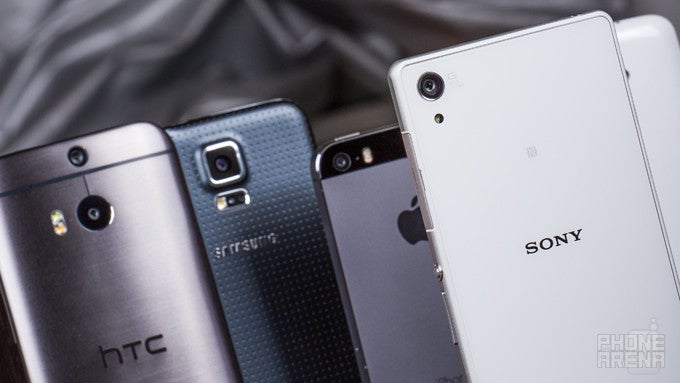
Introduction
Over the past several weeks, we've been enjoying the presence of the Sony Xperia Z2 at our office. We gave it the review treatment it deserved, we compared it thoroughly against many of its high-end rivals, and we even featured it in a recent blind camera comparison. There's still one more major item on our “to do” list, however – an in-depth camera comparison dedicated to Sony's new smartphone. Well, this gets written off with the post you're reading right now.
Yup, it is camera comparison time, and the Sony Xperia Z2 is having the honor of being the star of the show. Its impressive list of camera specs includes 20.7MP of resolution, G Lens optics, and 1/2.3" image sensor, which means that Sony's flagship has the potential to emerge triumphant once we take it through its paces. Just let's not forget that the Z1's camera was identical, yet it had its drawbacks. Has Sony managed to implement any significant improvements in its flagship's camera?And no less importantly, how is it going to stack up against the Samsung Galaxy S5, the LG G2, the HTC One (M8), and the iPhone 5s? That's surely going to be one tough race, folks, knowing that all these handsets are pretty good at taking photos. So without further ado, let's take a look at some photo samples.
Note: We're using a Panasonic Lumix GH2 with its kit lens as a reference camera.

Colors
Color reproduction is the first thing that we'll comment on; color accuracy, to be more specific. The Sony Xperia Z2 performs well in this particular category, with only some insignificant deviations in its daytime images. Colors have a slight boost to them, but we don't see it as anything that bothers us. We also noticed that its photos turn out slightly brighter, which is a bit of a double-edged sword – shady areas are clearer, but brighter objects might get “burned” because of that.
The Samsung Galaxy S5 takes photos with mostly neutral colors in them and a slight cold-ish tone seen on some occasions. That same “burning” effect we mentioned can be seen in the S5's photos as well, but its presence isn't as pronounced as it might be with the Z2.
The LG G2 also performed really well this time around and nailed a good color balance in most of its shots. We see that it doesn't tend to oversaturate the colors it has captured. Some images, however, exhibit a slightly greenish tone.
Apple's iPhone 5s has a mind of its own when it comes to color representation. Its photos often turn out noticeably warm and bright, which can be good or bad, depending on how you look at it. On one hand, photos from the 5s are very attractive with their warmness, but on the other hand, we can't consider them accurate.
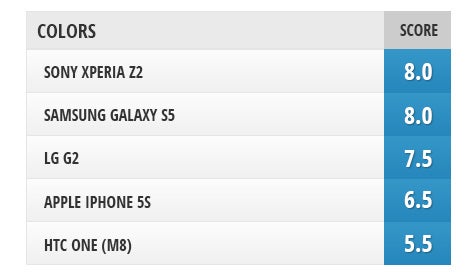
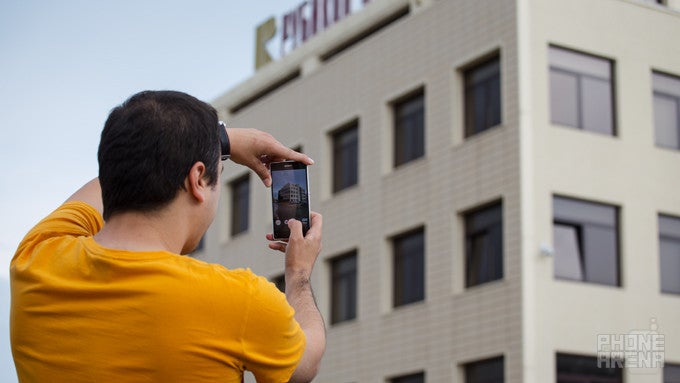
Detail
This one is also a tie between the Sony Xperia Z2 and the Samsung Galaxy S5. Although the two capture details differently, we can't say that one of them is better than the other at that.
By default, the Z2 starts in Superior Auto mode and takes 8MP photos, which are pretty much scaled down and enhanced 20.7MP ones – the produced images are very rich in detail and mostly free of artifacts. In case it is needed, the 20.7MP photo resolution is available in Manual mode, but once you zoom in close on these full-res images, you'll see plenty of unwanted artifacts. That's one of the reasons why an average user is advised to stick with Auto mode instead.
As for the Samsung Galaxy S5, its 16MP photos look very detailed indeed, but the camera's noise reduction algorithms along with the added sharpness render these details somewhat unnatural.
The LG G2 has a rather unique approach to capturing details in photos. We suppose that you will find these either very natural, or very awkward. To be more specific, 13MP photos from the G2 have very soft details and very little noise.
The iPhone 5s produces photos that are very high on details, especially for their resolution of 8MP. Details are natural, without any unnecessary sharpness, and digital noise is hard to spot in well-lit scenes.
Last in this category is the HTC One (M8), which isn't a surprise. Its 4MP photos are usable, but the phone's rivals are a league ahead. Zooming in on the One's photos reveals the absence of fine details. Noise is rather easy to notice.
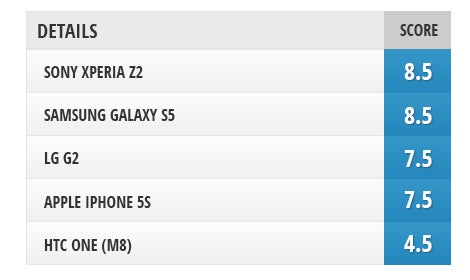
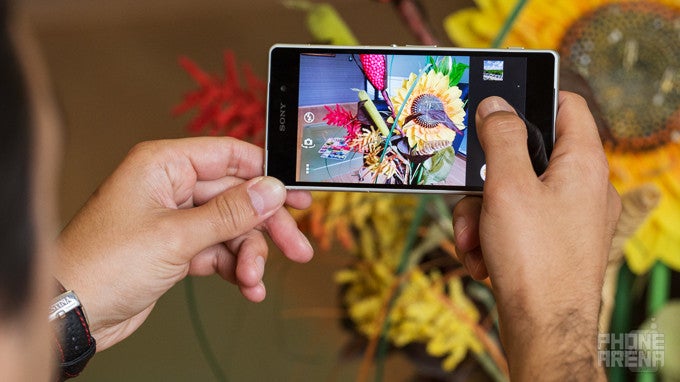
Indoor
Well, what do you know: the Sony Xperia Z2 has almost no troubles shooting with weak, artificial lighting in indoor environments. Colors are mostly natural, details are plentiful, and digital noise is well within tolerable limits. Its LED light is strong and does not disrupt the image's color balance.
The Samsung Galaxy S5 performs equally well in well-lit scenes, and in darker ones, it proves that it can produce slightly more detailed shots than the Z2. There's more digital noise in these low-light scenes, however, and the S5's LED light makes photos appear colder.
The boost in brightness and warmth is, again, noticeable in photos from the iPhone 5s – they look fine like that, but a bit unnatural. In harder low-light scenes, however, Apple's smartphone takes beautiful photos, with plenty of details and pretty colors.
Indoor photos from the LG G2 look good only as long as there's a good amount of light available. As lights get dim, the presence of digital noise becomes apparent and details also suffer because of that. The G2 has a strong LED light that won't throw color fidelity out the window. It won't fire, however, unless light is really scarce. That's why you might need to force it to fire on certain occasions.
The HTC One M8 takes decent photos in well-lit indoor spaces, but it struggles in low light. In the latter scenario, its photos turn out quite unpleasant-looking, with colors that are way off. Details are of average quality, as expected. Yet we can't deny that the M8's two-tone LED light improves dark scenes dramatically.
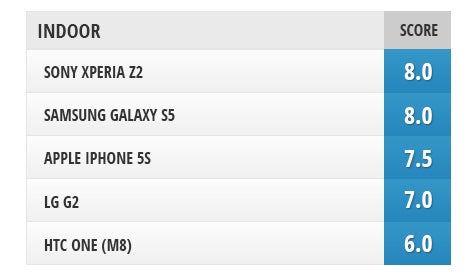
Panorama
The results in this category can hardly surprise us. As expected, the Samsung Galaxy S5 wins the panorama round with its outstanding panoramic images. Its panoramas are not only well stitched, but also highly detailed, with a total resolution exceeding 50 megapixels. The iPhone 5s is the only phone that comes close in panorama quality to the Galaxy S5. Apple's smartphone takes detailed and gap-free panoramas, but with a lower resolution of around 20 megapixels.
The HTC One M8 snaps panoramas of about 13 megapixels, and the results are satisfactory. Some stitching errors can be seen here and there, but overall, its panoramas turn out pretty decent. We wish we could say the same about the Z2's panoramas, however. Its images lack detail and contain way too much “accordion” glitching, which makes them unacceptable. And lastly, there's the LG G2. Its panoramas suffer from a serious detail deficiency and just aren't pretty.
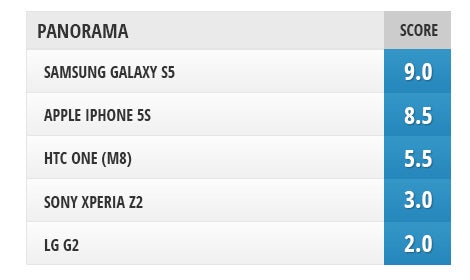
HDR
All of these five phones have the option to take HDR photos – composite images in which details in darkest an lightest areas are boosted. Some, however, are better than others at this. The Samsung Galaxy S5 is one of our favorites. Turning its HDR mode on improves details in shaded areas dramatically, although the image looks slightly unnatural with the mode on. The iPhone 5s has much less aggressive HDR algorithms, and the result is an HDR image that's a lot more true to life.
Next in the ranking stands the HTC One (M8). Its HDR photos look not quite realistic, but darker and lighter areas turn out much clearer. Then there's the LG G2. The HDR photos from it have a realistic appearance despite the color inaccuracies that may result from the mode's use.
Trailing behind the pack is the Sony Xperia Z2. Surprisingly, its HDR photos don't look like like such at all. They exhibit a drastic loss in contrast, and we can't see much of an improvement in the way the light and dark zones of the image look.
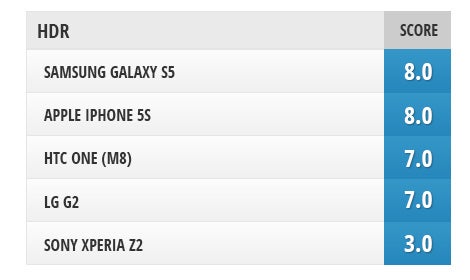
Night
The iPhone 5s has bested many of our night-time camera comparisons with its well-taken photos. It manages to strike a good balance between details and digital noise, all the while capturing colors very accurately. Night photos from the S5 are about as detailed despite the higher resolution of the sensor. Color accuracy is also very good. Overall, the iPhone 5s and the Galaxy S5 perform equally well when shooting night scenes.
The Sony Xperia Z2 and the LG G2 can both take good photos at night, but results tend to be inconsistent. The former renders some scenes warmer than it should, and focusing could also be an issue. As for the latter, some of our samples turned out very detailed, while details in others were too soft to us. Lastly, the HTC One (M8) takes mediocre night photos. They are okay, of course, but bright objects in them appear as blobs of white light.
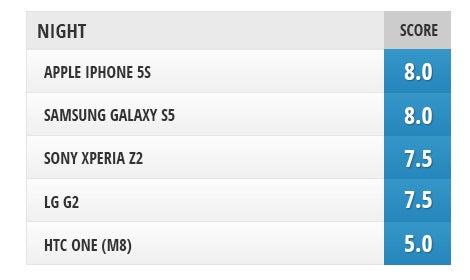
Video
You'd be surprised just how stable the iPhone's 1080p videos are, given the fact that its camera relies on software anti-shake methods, not on optical ones. Footage is smooth and, in general, free of noise. Even at night, the image stabilization does a commendable job, and the noise level is tolerable. Overall, the iPhone 5s excels when it comes to taking videos. There's just one thing – sound in its videos is mediocre at best.
About as good of a video-taker as the iPhone is the Galaxy S5. Its 1080p videos, taken at 30 or 60 frames per second, pack a great amount of detail, but aren't as stable. What's more, the S5's night videos leave something to be desired. Sound quality is above average.
The Sony Xperia Z2 performs well, but kind of expected to see more. Colors are neutral, footage is smooth, but details aren't as sharp and pronounced like they are in S5's videos. Moreover, the software image stabilization does keep the frame very steady, but at the same time, it adds traces of pixelated artifacts around moving objects. Traces of motion blur are seen in the phone's night videos. As for its audio quality, the Z2 captures loud and clear sound in its videos, with a noticeable presence of low-frequency tones.
Next on the chart ranks the HTC One (M8). Its videos are smooth and detailed, with neutral colors, quick auto-focus, and excellent sound quality. Night photos are also pleasant to look at, although there's some motion blur noticeable in very low-light scenes.
As for the LG G2, its daytime videos look great, especially when captured at 60fps. The built-in optical stabilization is why its footage is so steady. In low light, however, the G2 can be very unreliable. Even at 30 frames per second, its videos may suffer from heavy motion blur. Sound quality is average. Audio is loud, but heavily digitized.text
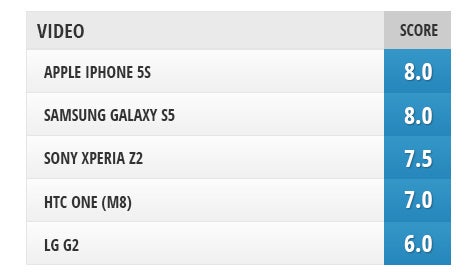
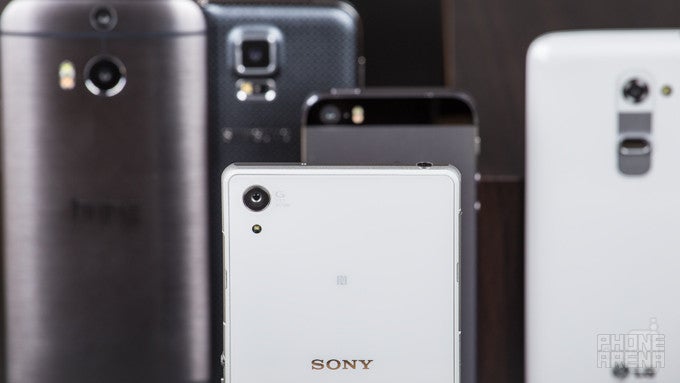
Conclusion
As its predecessor, the Sony Xperia Z2 is an excellent cameraphone and a worthy competitor to the best shooters out there. Sony's flagship performed commendably in most of our tests, outrunning all of the challengers but the Galaxy S5. Failures weren't absent, however. The Xperia Z2 can't capture HDR and panorama images well, but other than that, we're very pleased with the images produced by Sony's smartphone.
At the same time, we can't label the camera on the Sony Xperia Z2 as superior to the one on the Galaxy S5. It isn't any worse either. As a whole, both phones are equally capable in the camera department, as it becomes evident from their final scores and from the images that they produced. Most notably, the Z2 and S5 excel in taking detailed photos with accurate colors, both indoors and in broad daylight.
The LG G2 may be nearing the end of its flagship status, but its camera should not be underestimated. With 13MP of resolution and optical image stabilization at its disposal, it produces very likeable photos in a variety of conditions. Hopes are high that whatever smartphone comes after the G2, it should carry a camera no less potent than the one on the Z2 and the S5.
Then we have the iPhone 5s, which once again proves that 8MP of resolution should be enough for the average consumer's needs. Apple's smartphone is extremely easy to use, all the while enabling us to capture beautiful photos and videos. Color accuracy, however, isn't its strength.
Lastly, we are once again being reminded that the HTC One (M8), with its UltraPixel camera, can't match the performance of its rivals when it comes to taking photos. The phone's images are decent, but nothing extraordinary, lagging in detail presence and color accuracy when compared to images from other high-end devices.
The final score for each phone represents its average rating, but note that we're only taking into account the Details, Color representation and Indoor categories in the final score. We're factoring all the others (such as Night and Panorama) out, since those represent situations where users are less likely to take images in. Video recording isn't included either, since we consider it a separate thing from photo-taking. We've done this in order to end up with a final rating that is representative of a camera's performance in those areas, which we think are most important to users.
You can now read:
- iPhone 6 vs iPhone 6 Plus vs iPhone 5s vs Galaxy S5 vs LG G3 vs Lumia 1520 vs Xperia Z2 vs HTC One (M8) Camera comparison
- Samsung Galaxy Note 4 vs iPhone 6 vs iPhone 6 Plus vs Sony Xperia Z3 vs LG G3 vs Galaxy S5 vs Galaxy Note 3 Camera comparison








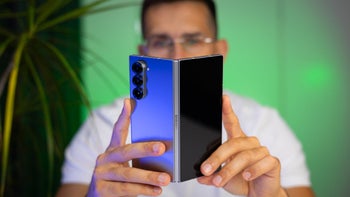









Things that are NOT allowed: